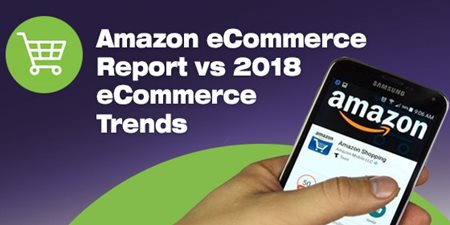eCommerce: Amazon’s 2018 Challenges vs. 2019 Trends
It seems that online retail is now the new mainstream commerce model. The ease of buying, shipping and the sheer vast availability of retailers – from mom and pop local shops, to niche products to large online retailers like Target and Whole Foods – it is driving consumerism and digitizing the market more than ever.  However, as successful as eCommerce is, it comes with the series of its challenges. Companies, or entrepreneurs, or freelancers in this space will need to continue to adapt to the difficulties appearing, understand the trends, all while striving to succeed in an ever-evolving market.
However, as successful as eCommerce is, it comes with the series of its challenges. Companies, or entrepreneurs, or freelancers in this space will need to continue to adapt to the difficulties appearing, understand the trends, all while striving to succeed in an ever-evolving market.
Every year, Amazon releases an annual report from the past fiscal year, which summarizes the company's growth, but more importantly, goes into detail and highlights some of the key challenges and obstacles that will face the company and more so the eCommerce industry as a whole. Amazon is one if not, the biggest eCommerce companies in the entire world. The information contained in their reports can provide online retailing companies – of any size – the potential issues and risks for the year ahead that all eCommerce businesses should consider.
As 2018 is ending and we look ahead to 2019, we compare the top 5 challenges reported by Amazon for 2018, and compare them to how they potentially impact or guide the trends ahead for online retailers in 2019.
Challenge 1: Channel expansion, high growth pains, and a rapidly evolving Business Model
As Amazon continues to scale up operations and diversify with new products, services, and expand its verticals such as the acquisition of Whole Foods, its rapid growth would present a unique set of challenges that can quite easily position the company to be more vulnerable to risk.
“This expansion increases the complexity of our business and places significant strain on our management, personnel, operations, systems, technical performance, financial resources, and internal financial control and reporting functions. We may not be able to manage growth effectively, which could damage our reputation, limit our growth, and negatively affect our operating results.”
With channel expansion and high growth, business models will need to become ever evolving to keep up with change, and, focus on how rapidly changing technology and industry trends can impact your business.
“This is an important insight (and a good reminder) to all ecommerce companies going through a period of rapid growth.”
Trends for 2019:
Digitizing Real World Experiences: By including interactive digital experiences in-store you can create a sense of wonder for customers. A 2018 report found that on average 38% of people, and 51% of millennials would find a physical store visit more exciting if the retailer used technology. In 2019 we’ll see more brands using technology in store to keep visitors engaged.
Mobile-first Commerce: As more and more consumers shop on the go, it will become essential for businesses to adopt a mobile-first strategy. Forrester predicts that by 2022, smartphones will account for $175.4 billion (USD) in retail sales. Mobile-first can mean updating your checkout process to ensure it’s user-friendly through to considering Accelerated Mobile Pages (AMP), a framework that enables you to create super fast website pages across mobile devices.
Challenge 2: The Risks of International Expansion
Another significant challenges for Amazon, as detailed in their report, relates to their expansion into current and new international markets around the world. Some markets they have no to little operating experience and may not benefit from any first-to-market advantages or otherwise actually succeed. Additionally, for a business it is costly to establish, develop, and maintain international operations and websites, and promote and advertise internationally. Some additional risks identified, which retailers with a current or future international expansion need to consider: economic and political conditions, international regulations on ecommerce, business licensing in countries and states, currency exchange restrictions, language and cultural differences and net neutrality.
Trends for 2019:
Multilingual Chatbots: Chatbot have popped up across the web, with no sign of slowing down and have been instrumental in the expansion of companies overseas who benefit from providing customer service in the customers native language.
Omni-channel eCommerce: Reach customers at more touch points with an omnichannel strategy. Omni-channel is a multi-channel approach to sales and marketing that aims to provide customers with a seamless shopping experience no matter where they. From mobile commerce to brick and mortar stores, your customer’s purchase path should be as painless as possible.
Niche Markets and D2C Brands: Big brands are branching out to cover narrower niches with separate new brands so the main one doesn’t cast irrelevant shadows. The market is going into smaller and smaller fractions and businesses need to explore how it could be a separate venture with its own target and identity when planning an expansion.
Challenge 3: Optimization of Data Fulfillment
Along with rapid growth, Amazon identified another set of challenges relating to the optimization of its data as well as its fulfillment centers. This is a very relatable concern for any ecommerce retailer that’s growing quickly. The report states:
“If we do not adequately predict customer demand or otherwise optimize and operate our fulfillment network and data centers successfully, it could result in excess or insufficient fulfillment or data center capacity, or result in increased costs, impairment charges, or both, or harm our business in other ways.”
Online retailers need to consider that they should ensure their inventory is optimized, as it will help to lower shipping costs from fulfillment centers, and you have developed a strong relationship with shipping companies and have negotiated and clearly outline your terms.
Trends for 2019:
Automation: eCommerce has possibly the most to gain from automation. Automation in this context refers to the creation and application of technology to streamline a number of processes, such as sales, marketing, inventory management, production and delivery services.
Delivery Options: Speed and efficiency continue to be key drivers for ecommerce for the fifth year in a row. Over 40% of online consumers have used same day delivery service in the past year and are seeking greater convenience. Businesses need to optimize their supply chain and explore better delivery options.
Challenge 4: Seasonality and Holiday Strain
Like any online retailer, or even brick and mortar store, Amazon identified seasonality and holiday strain as a challenge. They face a massive influx of traffic and orders during mainly during the fourth quarter due to customers year-end holiday shopping surge, however these also peak at other times of years around specific holidays. Retailers will need to prepare for seasonality and holiday strain by forecasting demand for inventory and ensure there is enough stocked, potential increases in shipping costs, website outages and slow speed due to traffic, and potential additional staffing requirements.
Trends for 2019:
Site Performance: In 2019, expect site performance monitoring to become an key need for ecommerce companies, as an extension of SEO and user experience.
“According to Google, the average time it takes for a mobile landing page to load is now 22 seconds. Compare that with the three seconds visitors need to decide if they want to stay for your page to load. While page speed is important for your SEO, it is even more important for your UX, conversion, and general customer happiness.”
Google has made page speed a ranking factor. Good ecommerce websites will be fast-loading progressive web apps and accelerated mobile pages.
Challenge 5: Government regulation
With new and changing of laws and trade agreements, economic recessions, and political up rest, there’s a lot up in the air right now around government regulation which impacts companies like Amazon, but also for ecommerce retailers in general, too. Businesses will need to keep a close eye on legislative impacts including data protection, taxation, online payment services and restrictions and laws around energy consumption.
Trends for 2019:
Payment Options: There are so many online payment methods available nowadays from Cryptocurrency to digital wallets and even instant layby. The Washington Post reported that 70% of people believe that mobile payments will overtake cash and cards by 2030. Consumers will continue to demand varying forms of payment and an easier checkout experience; therefore businesses will need to streamline and improve ways for customers to pay in 2019.

Lynette Sawyer
Lynette Sawyer is a Web Project Manager for Falcon-Software, a digital web agency founded in 1994. For the last 13-years Lynette has been in various digital capacities and her expertise goes beyond Project Management. Lynette brings experience and knowledge in graphic design, marketing communications, project management, product management and engagement.